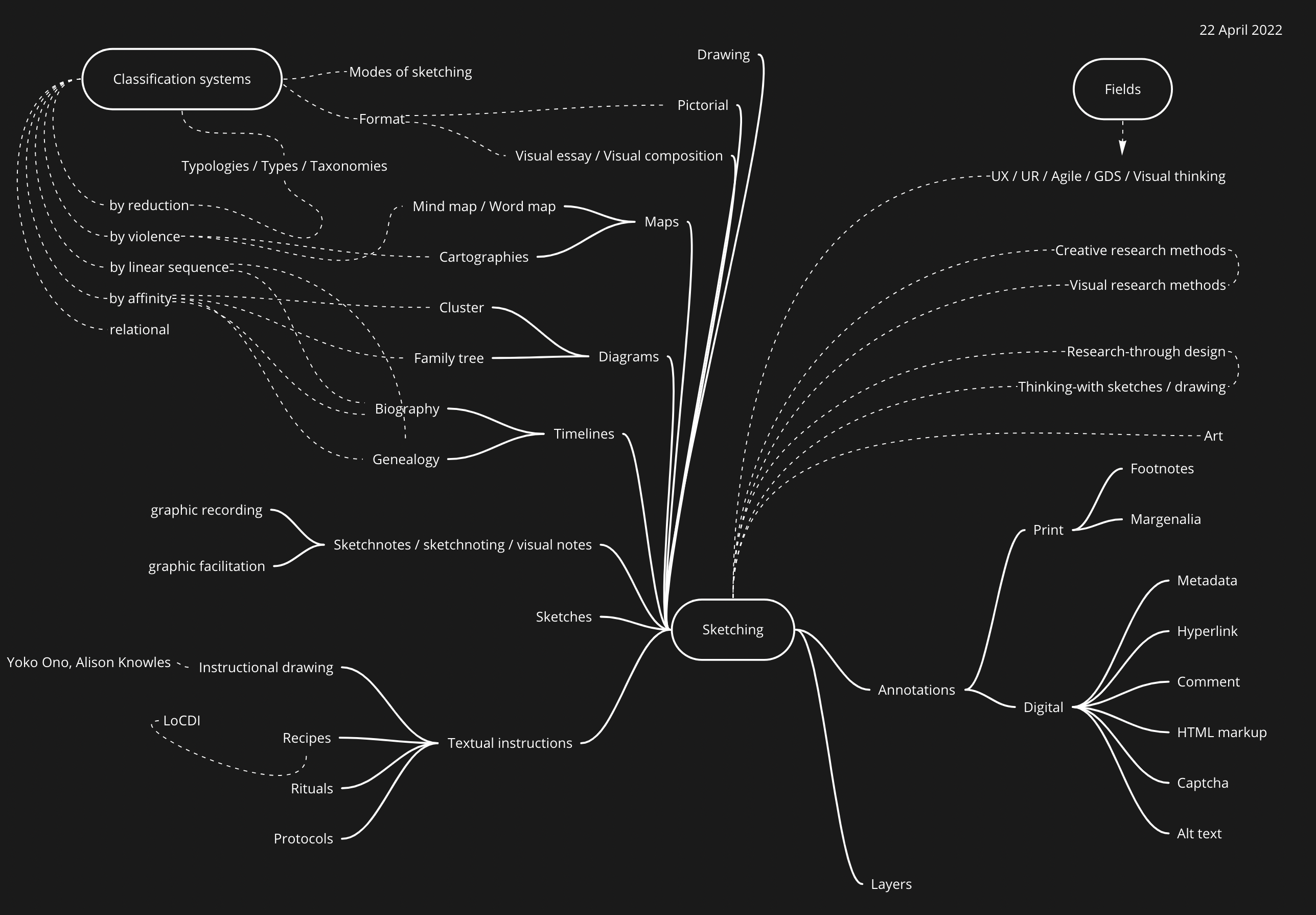

I am a design researcher whose work focuses on
the politics of and in collaborative
design research methods such as co-design and
participatory design.
I believe that feminist, queer, decolonial, anti-racist thought offer ways to work through
and address the power configurations that come with design research methods.
I focus specifically on the politics of participation together with exploring the potential
of sketchnoting as a visual research tool.
Within this analysis I am particularly interested in questioning design research methods
Engaging with questions such as:
by who,
for whom,
what for,
for whose benefit at the cost of whom?
to engage with the underlying power structures in design research methods
(norms, logics, values, etc) and what else is obscured in them.
By design research I am referring to …
By politics of and in design research methods I mean the power configurations
that come with the research methods we use. As an example …
By collaborative design research methods I mean ...
I am particularly interested in the politics of participation: who gets to be involved, in what way and who doesn't?
This questioning of research methods is guided by three questions:
1 - The need for criticality in design research methods
? How are these methods in conversation with the politics of and in design research?
How have the politics of participation been addressed in design research?
What is the use of our methods? What do they do to matter?
2 - Whose and what knowledge is considered valid according to whom, when and where?
The hierarchical constructions of knowledge production.
Epistemologies that focus on social justice / critical epistemologies (?),
that make power dynamics visible and addressable (power relations;
hierarchies of knowledge/classification/… fixed positions) and centre
marginalised voices (focus on absence, exclusion, agency, voice, subjectivity;
relational; biography; genealogy)
3 - How the hierarchical constructions of knowledge production are continued /
embodied in our design research methods
Design research methods as a continuation of the hierarchical constructions of
knowledge production.
A questioning of research methods and methodologies as instrumentalised.
Who constructs them, for whom, what for and in what way?
As an example Flavia Dzodan’s Genealogy of big data.

To engage with this topic I rely on the work developed in critical epistemologies:
feminist,
queer,
decolonial,
anti-racist,
critical theory.
I believe that an inquiry approach based on this critical work is better prepared to
address the politics of design research methods because of the ways they analyse
how power structures are created, enacted and maintained.

Because I use visual tools, my specific contribution lies in using sketches as devices to make things visible and addressable. I am invested in finding ways of making the power dynamics that are obscured in design research methods visible through the use of sketching. 👉 How sketching as a collaborative design research tool produces different ways of knowing: - It is a way of generating knowledge - It generates a specific kind of knowledge: what kinds of knowledge emerge through the use of sketching as a tool? - It is a way of generating knowledge collaboratively (contribution area) 👉 Contribution: Make this questioning visible and addressable && sketching as a visual research tool As devices these sketches facilitate several explorations: - as a probing/inquiry device these sketches facilitate a visual analysis that makes explicit what we know, not know, want to know - as individual devices they facilitate for reflexive processes to draw out positionalities and subjective experiences that can be shared and placed that at the centre of a process - as a surface for exchange these sketches facilitate conversations that allow for ways to build knowledge collaboratively, iteratively - as travelling devices these sketches allow for knowledge to be circulated, discussed and validated Paying specific atttention to: Authorship and absence / Voice and agency / Inclusion and exclusion As a surface for exchange they provide for ways of generating knowledge collaboratively, this raises questions around authorship. I argue that, as conversation sites, sketches are capable of holding multiple voices and understandings. Yet, who is speaking is obscured in these sketches. Who is speaking in these sketches, who is being spoken of? Who is holding the pen? Whose norms, logics, priorities, understanding, experiences, beliefs, … world views are being prioritised? Taken as a point of reference? Whose are not? Who is holding the pen: a framework for making power dynamics explicit / the what you pay attention to + by putting it on paper you are making it open for discussion = I am holding the pen, but someone else is speaking. Sketch reading = Sketching as a subjective reading, like a tarot reading. Whose voices are absent and obscured in these sketches? And, what else does the sketch obscure? Layering as a specific mechanism in sketching Contribution is the identification and analysis of layering as a mechanism for carrying out collaborative research through visual compositions. Layering as patterning for looking at things. Layers = relations, mode and roles. Sketching as an archeological expedition: Layers of information, of stories in the form of annotations, footnotes, comments, highlights. Digital layers: folder names, file names, layer names Layers in a cake https://www.instagram.com/p/CbuSgLVI6Ef/ Layers as relational. Sketching as relational? Using sketches as a site for collaboration means proposing it as a relational tool. What kind of relations are at play in this process? Turn-taking, exchange, correspondence.
1. Work through this list of readings to annotate
2. Continue with visual essays



~~~
Sketches as a relational tool in design research processes
Contribution is the identification and analysis of layering as a
mechanism for carrying out collaborative research through visual
compositions.
 But I felt the urge to continue
But I felt the urge to continue
 Sketching as a conversation interface
Sketching as a conversation interface